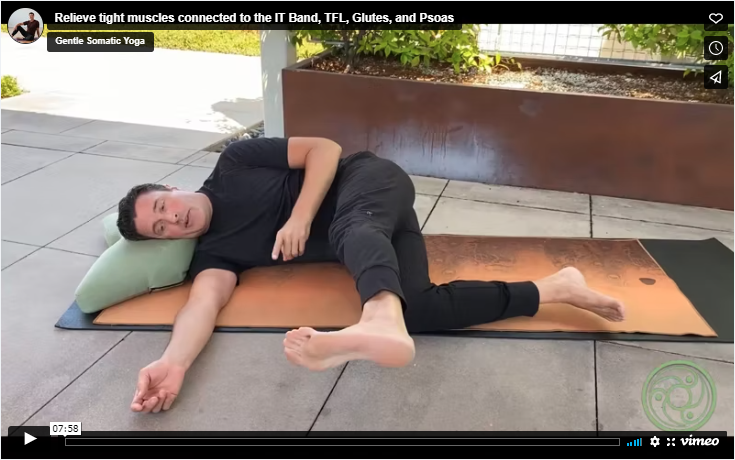View basket (0 items $0.00)

Somatic TFL and Psoas Release
The past few years of navigating COVID have been an exercise in letting go of expectations. I am reminded to release what can’t be right now and maintain peace in the face of the unexpected. It’s also given me time for self-reflection and to enjoy these moments while being grateful for all the blessings in my life. In honor of our collective exploration of the novel and unpredictable nature of our lives in this historical time, I’m offering a new somatic movement flow. This flow focuses on the lower back, hips, and legs.
Somatic Movement Flow for Those Who Sit or Stand All Day Long
The Somatic Movement Flow in the video above can help those of us that sit for lengths of time, like the desk worker, and it can be especially useful to people who are standing on their feet all day. A huge thank you to service workers: retail, hospital and healthcare, and food service to name a few. This flow can help relieve the pain in the lower back and hips that come with the pressure of standing or sitting too long.
This is also for people who like to walk, hike, run, or bike, as this is an excellent sequence to improve performance and strength. This Somatic Movement Flow called the “Somatic TFL and Psoas Release,” will reset the inner and outer thigh muscles to their optimal length in a resting position. This means you gain flexibility, strength, and range of motion.
 What Are the TFL and Psoas Muscles?
What Are the TFL and Psoas Muscles?
The key benefit to this flow is the release of tightness in the TFL (tensor fasciae latae), the IT (iliotibial) band, and the psoas muscle. The tensor fasciae latae muscle group helps to stabilize the hip in extension and assists the gluteus maximus during hip extension.
The psoas is the primary muscle group that connects the upper body to the lower body. Its function is a major contributor to hip joint flexion and plays an essential role in helping us walk. The psoas also affects posture and stabilizes the spine. Most people in the modern world have tight psoas muscles. This can cause a multitude of problems such as chronic low back pain, poor posture, constipation, leg length discrepancy, internal or external leg rotation, and sciatica.
The iliotibial band (IT band) is a long piece of connective tissue, or fascia, that runs along the outside of your leg from the hip to the knee and shin bone. This band helps to extend and rotate the hip. It works with the quadriceps (front thigh muscles) to provide stability to the outside of the knee joint during movement.
Please enjoy practicing this Somatic Movement Flow and enjoy the immediate benefits of release. Enjoy!
Reprinted with permission from James Knight/Founder of GentleSomaticYoga.com

James has been an E-RYT, CHSE (Certified Hanna Somatic Educator), and Integrative Therapist for 25+ years. His passion is to inspire and encourage others to live a fulfilling life of physical, emotional, and spiritual freedom. From his combined experience as a lifelong yogi, intuitive bodyworker, psychotherapist, and movement educator, James founded a method of integrating what he discovered to be the most progressive, life-enhancing techniques into an embodied practice of mindful movement. Gentle Somatic Yoga (GSY) was born out of years of exploring means of connecting with the most profound aspects of himself.
As an architectural and interior designer, master Feng Shui consultant, and professional photographer, James enjoys designing sacred spaces and other creative endeavors that reflect his spiritual aesthetic. On a personal level, he enjoys spending quality time with loved ones while cultivating and energizing a conscious community. James spends much of his time traveling the world facilitating teacher training certifications, workshops, and cultural immersion retreats.
Featured Courses










